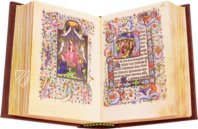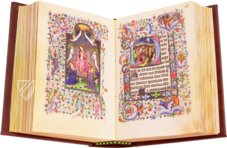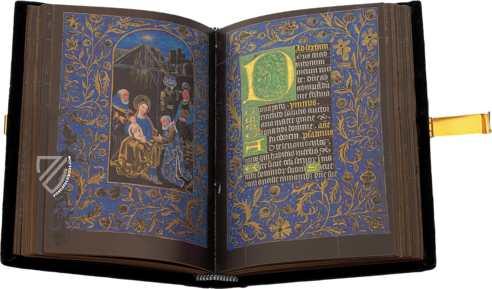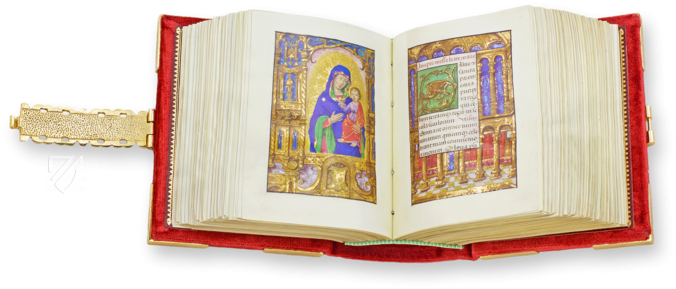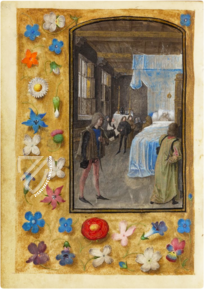Hours of the Master of Guillebert de Mets
(7,000€ - 10,000€)
The rich and sophisticated court of the Dukes of Burgundy patronized countless illuminated manuscripts, which were mostly created in the Low Countries. These manuscripts are counted among the finest works of medieval book art. One of the masterpieces produced during the first half of the 15th century is the Officium Beatae Mariae Virginis of Guillebert de Metz, likely created for the wife of one of Duke Philip the Good’s courtiers. The standard liturgical text is appended with a Vita of Saint Barbara and a calendar with saints from the Diocese of Utrecht. It is adorned by 23 miniatures, numerous historiated initials, and gorgeous floral bordures filled with human, animal, and hybrid figures. The richly illuminated manuscript was designed with a complete image program that is consistent throughout, making it a true masterpiece of the Gothic style.
Hours of the Master of Guillebert de Mets
During the Late Middle Ages, the rich, powerful, and sophisticated Dukes of Burgundy created the most learned and splendid court in Europe. The Burgundian aristocracy and the growing Burgher class – the medieval bourgeoisie – patronized countless works of art including panel paintings and illuminated manuscripts. This resulted in the formation of a whole bookmaking industry in the Low Countries, which were part of their lands. One of the finest examples of this explosion of creativity is the Officium Beatae Mariae Virginis of Guillebert de Mets, which was created sometime before 1450.
A Gothic Masterpiece
In the manuscript, 23 gorgeous miniatures depict episodes from the life of Christ, the Virgin Mary, and Saint Barbara, but the calendar section is filled with saints from the diocese of Utrecht. Colorful acanthus leaf bordures highlighted with gold leaf fill the margins of both the miniatures and the text pages, which feature elaborate historiated initials. Countless human and animal figures, as well as grotesques, fill the leafy frames. The work’s style and decorative program are both gorgeous and consistent, which is what makes it a true masterpiece. It is attributed to the Master of Guillebert de Mets, also known as the Master of the Silver Skies for his frequent use of silver leaf.
The Master(s) of Guillebert de Mets
There is some debate as to whether there was more than one Master of Guillebert de Mets. Rather than being an alternate name, the Master of the Silver Skies is likely a second master. They appear to have been active in the Flemish city of Ghent between 1415 and 1450 and their work displays typical stylistic elements such as the floral borders. Various elements of the French Gothic style can be seen in the composition of the miniatures, indicating that at least one of the masters had been trained in Paris. Furthermore, they were strongly influenced by the Boucicaut Master and the Bedford Master. Whether it was an individual or a group, this name of convenience is a reference to evidence of frequent collaboration with the Flemish scribe and copyist Guillebert de Mets, who was active around the same time. This evidence of an ongoing working relationship speaks to just how advanced and professional the manuscript trade in the modern Netherlands had become by the 15th century.
Journey of the Manuscript
It is believed that the manuscript was patronized by a member of the court of Duke Philip the Good (1396-1467) who was a member of the Order of the Golden Fleece as a gift for his wife, who may have been named Barbara judging by the patron saint chosen for the text. After passing through the hands of various nobles through the centuries, codex was donated by the Count of Brescia Durante Duranti (1718-1780), poet imitator of Parini, “to the valiant Father Abate Trombelli”. He in turn donated the manuscript to the library of the Convent del SS. Salvatore, which cataloged the work in the 18th century with the shelf mark 780. In the opinion of Frati, the codex was donated to Duranti by the Duke of Savoy and King of Sardinia Charles Emmanuel III (1701-73) in 1755 to thank him for the dedication of his rhymes. In either case, the manuscript remained in the library until it was taken during Napoleon’s invasion in 1796 before returning to Italy in 1828. It was then donated by the canons to what was the Pontifical Library at the time before eventually making its way to the University of Bologna Library, where it is stored today under the shelf mark ms. 1138.
Codicology
- Alternative Titles
- Officium Beatae Virginis et mortuorum
Offiziolo di Guillebert di Metz
Officium Beatae Mariae Virginis von Guillebert de Metz - Size / Format
- 600 pages / 18.5 × 13.5 cm
- Origin
- Belgium
- Date
- Ca. 1430–1440
- Epochs
- Style
- Language
- Script
- Gothic Textura
- Illustrations
- 23 large miniatures; historiated initials; borders and marginalia
- Content
- Liturgy of the Hours, Vita of Saint Barbara and various saints from the diocese of Utrecht
- Artist / School
- Master of Guillebert de Metz
- Previous Owners
- Durante Duranti
Padre Abate Trombelli
Biblioteca del Convento del SS. Salvatore (Bologna)
Biblioteca Pontificia
Hours of the Master of Guillebert de Mets
Catherine of Alexandria
Since the 7th century, St. Catherine of Alexandria has been venerated as a Christian martyr who fell victim to the Persecution of Christians in late antiquity. Legend has it that she was a virgin who dedicated her life to Christ and stood up for her faith with great persuasion. She even converted the Roman empress to Christianity. In the end, she was castigated for days for her steadfastness. Her attempted quadripartition with the wheel failed as the instruments of execution broke due to divine intervention, whereupon she was finally beheaded. This is why she is usually depicted, as here, with both instruments of her martyrdom: The wheel and the sword. In this wonderful miniature, Catherine's triumph over the pagan emperor and also over death comes to the fore. With a golden crown and shining halo, she looks down on her opponent lying on the ground, who was unable to dissuade her from her faith, which in turn grants her eternal life.

Hours of the Master of Guillebert de Mets
The Last Judgement
This gold-decorated page shows the Last Judgement against a diffuse background. Christ appears as the Judge of the World flanked by two angels holding a sword and a lily, symbolizing both the justice and mercy of God as well as the two natures of Christ. Seated on a rainbow, Christ presents his bleeding stigmata; his feet rest on a sphere in accordance with the biblical saying: "Heaven is my throne and the earth is the footstool of my feet!" (Is 66,1) At the same time, two angels blow the trumpets of the Last Judgement while Mary and John, kneeling, pray for the resurrected, naked souls who are about to be judged.
The figurative marginal illuminations in the beautiful border directly refer to the Passion of Christ and his conquest of death for the salvation of mankind: six angels present some of the Arma Christi, the Instruments of the Passion associated with his suffering and death. The two upper angels carry the tools of the Flagellation, the column and the flagellums. The Holy Lance can be seen on the left, the vinegar-soaked sponge and the Crown of Thorns below.

#1 Offiziolo di Guillebert di Metz
Language: Italian
(7,000€ - 10,000€)
- Treatises / Secular Books
- Apocalypses / Beatus
- Astronomy / Astrology
- Bestiaries
- Bibles / Gospels
- Chronicles / History / Law
- Geography / Maps
- Saints' Lives
- Islam / Oriental
- Judaism / Hebrew
- Single Leaf Collections
- Leonardo da Vinci
- Literature / Poetry
- Liturgical Manuscripts
- Medicine / Botany / Alchemy
- Music
- Mythology / Prophecies
- Psalters
- Other Religious Books
- Games / Hunting
- Private Devotion Books
- Other Genres
- Afghanistan
- Armenia
- Austria
- Belgium
- Belize
- Bosnia and Herzegovina
- China
- Colombia
- Costa Rica
- Croatia
- Cyprus
- Czech Republic
- Denmark
- Egypt
- El Salvador
- Ethiopia
- France
- Germany
- Greece
- Guatemala
- Honduras
- Hungary
- India
- Iran
- Iraq
- Israel
- Italy
- Japan
- Jordan
- Kazakhstan
- Kyrgyzstan
- Lebanon
- Liechtenstein
- Luxembourg
- Mexico
- Morocco
- Netherlands
- Palestine
- Panama
- Peru
- Poland
- Portugal
- Romania
- Russia
- Serbia
- Spain
- Sri Lanka
- Sweden
- Switzerland
- Syria
- Tajikistan
- Turkey
- Turkmenistan
- Ukraine
- United Kingdom
- United States
- Uzbekistan
- Vatican City
- A. Oosthoek, van Holkema & Warendorf
- Aboca Museum
- Ajuntament de Valencia
- Akademie Verlag
- Akademische Druck- u. Verlagsanstalt (ADEVA)
- Aldo Ausilio Editore - Bottega d’Erasmo
- Alecto Historical Editions
- Alkuin Verlag
- Almqvist & Wiksell
- Amilcare Pizzi
- Andreas & Andreas Verlagsbuchhandlung
- Archa 90
- Archiv Verlag
- Archivi Edizioni
- Arnold Verlag
- ARS
- Ars Magna
- ArtCodex
- AyN Ediciones
- Azimuth Editions
- Badenia Verlag
- Bärenreiter-Verlag
- Belser Verlag
- Belser Verlag / WK Wertkontor
- Benziger Verlag
- Bernardinum Wydawnictwo
- BiblioGemma
- Biblioteca Apostolica Vaticana (Vaticanstadt, Vaticanstadt)
- Bibliotheca Palatina Faksimile Verlag
- Bibliotheca Rara
- Boydell & Brewer
- Bramante Edizioni
- Bredius Genootschap
- Brepols Publishers
- British Library
- C. Weckesser
- Caixa Catalunya
- Canesi
- CAPSA, Ars Scriptoria
- Caratzas Brothers, Publishers
- Carus Verlag
- Casamassima Libri
- Centrum Cartographie Verlag GmbH
- Chavane Verlag
- Christian Brandstätter Verlag
- Circulo Cientifico
- Club Bibliófilo Versol
- Club du Livre
- CM Editores
- Collegium Graphicum
- Collezione Apocrifa Da Vinci
- Comissão Nacional para as Comemorações dos Descobrimentos Portugueses
- Coron Verlag
- Corvina
- CTHS
- D. S. Brewer
- Damon
- De Agostini/UTET
- De Nederlandsche Boekhandel
- De Schutter
- Deuschle & Stemmle
- Deutscher Verlag für Kunstwissenschaft
- DIAMM
- Droz
- E. Schreiber Graphische Kunstanstalten
- Ediciones Boreal
- Ediciones Grial
- Ediclube
- Edições Inapa
- Edilan
- Editalia
- Edition Deuschle
- Edition Georg Popp
- Edition Leipzig
- Edition Libri Illustri
- Editiones Reales Sitios S. L.
- Éditions de l'Oiseau Lyre
- Editions Medicina Rara
- Editorial Casariego
- Editorial Mintzoa
- Editrice Antenore
- Editrice Velar
- Edizioni Edison
- Egeria, S.L.
- Eikon Editores
- Electa
- Emery Walker Limited
- Enciclopèdia Catalana
- Eos-Verlag
- Ephesus Publishing
- Ernst Battenberg
- Eugrammia Press
- Extraordinary Editions
- Fackelverlag
- Facsimila Art & Edition
- Facsimile Editions Ltd.
- Facsimilia Art & Edition Ebert KG
- Faksimile Verlag
- Feuermann Verlag
- Folger Shakespeare Library
- Franco Cosimo Panini Editore
- Friedrich Wittig Verlag
- Fundación Hullera Vasco-Leonesa
- G. Braziller
- Gabriele Mazzotta Editore
- Gebr. Mann Verlag
- Gesellschaft für graphische Industrie
- Getty Research Institute
- Giovanni Domenico de Rossi
- Giunti Editore
- Graffiti
- Grafica European Center of Fine Arts
- Guido Pressler
- Guillermo Blazquez
- Gustav Kiepenheuer
- H. N. Abrams
- Harrassowitz
- Harvard University Press
- Helikon
- Hendrickson Publishers
- Henning Oppermann
- Herder Verlag
- Hes & De Graaf Publishers
- Hoepli
- Holbein-Verlag
- Houghton Library
- Hugo Schmidt Verlag
- Idion Verlag
- Il Bulino, edizioni d'arte
- ILte
- Imago
- Insel Verlag
- Instituto de Estudios Altoaragoneses
- Instituto Nacional de Antropología e Historia
- Istituto dell'Enciclopedia Italiana - Treccani
- Istituto Ellenico di Studi Bizantini e Postbizantini
- Istituto Geografico De Agostini
- Istituto Poligrafico e Zecca dello Stato
- Italarte Art Establishments
- Jan Thorbecke Verlag
- Johnson Reprint Corporation
- Josef Stocker
- Josef Stocker-Schmid
- Jugoslavija
- Karl W. Hiersemann
- Kasper Straube
- Kaydeda Ediciones
- Kindler Verlag / Coron Verlag
- Kodansha International Ltd.
- Konrad Kölbl Verlag
- Kurt Wolff Verlag
- La Liberia dello Stato
- La Linea Editrice
- La Meta Editore
- Lambert Schneider
- Landeskreditbank Baden-Württemberg
- Leo S. Olschki
- Les Incunables
- Liber Artis
- Library of Congress
- Libreria Musicale Italiana
- Lichtdruck
- Lito Immagine Editore
- Lumen Artis
- Lund Humphries
- M. Moleiro Editor
- Maison des Sciences de l'homme et de la société de Poitiers
- Manuscriptum
- Martinus Nijhoff
- Maruzen-Yushodo Co. Ltd.
- MASA
- Massada Publishers
- McGraw-Hill
- Metropolitan Museum of Art
- Militos
- Millennium Liber
- Müller & Schindler
- Nahar - Stavit
- Nahar and Steimatzky
- National Library of Wales
- Neri Pozza
- Nova Charta
- Oceanum Verlag
- Odeon
- Orbis Mediaevalis
- Orbis Pictus
- Österreichische Staatsdruckerei
- Oxford University Press
- Pageant Books
- Parzellers Buchverlag
- Patrimonio Ediciones
- Pattloch Verlag
- PIAF
- Pieper Verlag
- Plon-Nourrit et cie
- Prestel Verlag
- Princeton University Press
- Prisma Verlag
- Priuli & Verlucca, editori
- Pro Sport Verlag
- Propyläen Verlag
- Pytheas Books
- Quaternio Verlag Luzern
- Reales Sitios
- Recht-Verlag
- Reichert Verlag
- Reichsdruckerei
- Reprint Verlag
- Riehn & Reusch
- Roberto Vattori Editore
- Rosenkilde and Bagger
- Roxburghe Club
- Salerno Editrice
- Saltellus Press
- Sandoz
- Sarajevo Svjetlost
- Schöck ArtPrint Kft.
- Schulsinger Brothers
- Scolar Press
- Scrinium
- Scripta Maneant
- Scriptorium
- Shazar
- Siloé, arte y bibliofilia
- SISMEL - Edizioni del Galluzzo
- Sociedad Mexicana de Antropología
- Société des Bibliophiles & Iconophiles de Belgique
- Soncin Publishing
- Sorli Ediciones
- Stainer and Bell
- Studer
- Styria Verlag
- Sumptibus Pragopress
- Szegedi Tudomànyegyetem
- Taberna Libraria
- Tarshish Books
- Taschen
- Tempus Libri
- Testimonio Compañía Editorial
- Thames and Hudson
- The Clear Vue Publishing Partnership Limited
- The Facsimile Codex
- The Folio Society
- The Marquess of Normanby
- The Richard III and Yorkist History Trust
- Tip.Le.Co
- TouchArt
- TREC Publishing House
- TRI Publishing Co.
- Trident Editore
- Typis Regiae Officinae Polygraphicae
- Union Verlag Berlin
- Universidad de Granada
- University of California Press
- University of Chicago Press
- Urs Graf
- Vallecchi
- Van Wijnen
- VCH, Acta Humaniora
- VDI Verlag
- VEB Deutscher Verlag für Musik
- Verlag Anton Pustet / Andreas Verlag
- Verlag Bibliophile Drucke Josef Stocker
- Verlag der Münchner Drucke
- Verlag für Regionalgeschichte
- Verlag Styria
- Vicent Garcia Editores
- W. Turnowski Ltd.
- W. Turnowsky
- Waanders Printers
- Wiener Mechitharisten-Congregation (Wien, Österreich)
- Wissenschaftliche Buchgesellschaft
- Wissenschaftliche Verlagsgesellschaft
- Wydawnictwo Dolnoslaskie
- Xuntanza Editorial
- Zakład Narodowy
- Zollikofer AG




